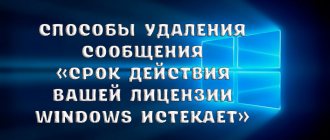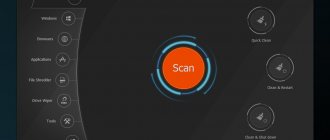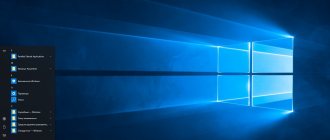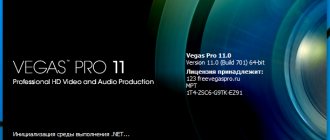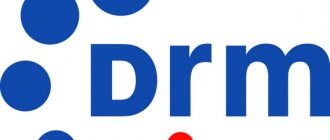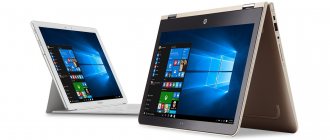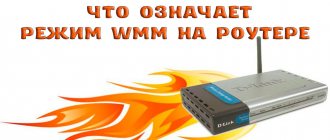What editions of Windows 10 are there?
There are only 6 main editions of desktop Windows 10:
- Home Single Language (Home SL) - Home for one language.
- Home - Homemade.
- Pro - Professional.
- Enterprise - Corporate.
- Education - For educational institutions.
- S - publication for students and educational institutions.
- Lean is not yet officially released, but only an edition under development for tablets with 16 GB of internal memory. Information on it will appear later.
Of course, there are other highly specialized editions. For example, the operating conditions for IT companies in China are slightly different than in other countries, so Microsoft created a special version of Windows 10 - Windows 10 China. However, an ordinary user from a CIS country is unlikely to encounter this, so we will not analyze such systems.
Note that Windows 10 editions often include Windows 10 Mobile, which is available in two versions:
- Windows 10 Mobile.
- Windows 10 Mobile Enterprise.
In fact, Windows 10 for smartphones is a separate operating system, so we won’t talk about it here either.
Windows 10 Rtm: How to Manage Accounts in Windows 10, What is Microsoft Id
What are Microsoft ID accounts? What is the difference between a Microsoft ID and a local account? by PIN code or image in Windows 10 and many other functions for working with users in Windows 10 - see this review of Windows 10. See everything about Windows 10 in a large playlist on my channel - how to install Windows 10, how to clean up disks, how work with the new features of Windows 10, what's new in Windows 10 -
?list=PLB5YmwQw0Jl8rYr0H3TcCFCYDFbvXB3e3 Windows 10 reviews to be continued…. *** Direct link to the site where you can buy a cheap CUBE iwork8 tablet, on which all videos about Windows 10 are currently filmed - https://www.tinydeal.com/cube-iwork8-u80gt-8-ips-windows-81 -16gb-intel-tablet-pc-p-131300.html?sk=78961564QE - tested by a year of work - there are no problems with this Chinese I have other CUBE iwork8 reviews on my channel -
Subscribe to my channel iWalker2000 - just click here - https://bit.ly/iwalker2000_subs Other Windows 10 reviews: * Windows 10 RTM: how to create a bootable USB flash drive to install Windows 10 - https://www.youtube.com/watch ?v=MQIaJW_Zuzg&list=PLB5YmwQw0Jl8rYr0H3TcCFCYDFbvXB3e3 * Windows 10 RTM: how to speed up the update to Windows 10 and remove error 0x80240020 -
* Windows 10 RTM: Forced upgrade to Windows 10 using Microsoft Media Creation Tool -
?list=PLB5YmwQw0Jl8rYr0H3TcCFCYDFbvXB3e3 * Windows 10 RTM: new Start menu/screen - how to work with it and configure it -
* Windows 10 RTM: what is Actions Center, how to use it and how to configure it -
* Windows 10 RTM: new features of virtual desktops (Virtual Desktops) + keyboard shortcuts -
?list=PLB5YmwQw0Jl8rYr0H3TcCFCYDFbvXB3e3 * Windows 10 RTM: new features of Tablet Mode in Windows 10 and how to work with it -
* Windows 10: How to install Windows 10 as a second system and not break anything - https://www.youtube.com/watch?v=uVd-IxhkKMU&list=PLB5YmwQw0Jl8rYr0H3TcCFCYDFbvXB3e3 * Windows 10 RTM: review of the most anticipated gaming feature - we run XBOX games on our PC/tablet - https://www.youtube.com/watch?v=0Q3yzIZ2vOw&list=PLB5YmwQw0Jl8rYr0H3TcCFCYDFbvXB3e3 * Windows 10 build 10240: initial setup after updating on a weak CUBE iwork8 tablet -
?list=PLB5YmwQw0Jl8rYr0H3TcCFCYDFbvXB3e3 * How to properly clear space on the Windows system drive (C:) and not break anything (detailed instructions from Igor Shastitko) -
?list=PLB5YmwQw0Jl8rYr0H3TcCFCYDFbvXB3e3 * review of the Microsoft Wireless Display Adapter - unboxing and testing with Windows/Android -
What is the difference between different editions of Windows 10
There are quite a lot of differences between the editions, but not everyone can understand them. We will look at the available editions based on a couple of criteria that can influence your choice of one or another Windows 10.
Where to buy a license for Windows 10, and how much does it cost?
In this section we will consider the possibility of purchasing a license for a particular edition of the system from the point of view of an ordinary user.
- Home SL : this edition is the cheapest, but the average user cannot buy a license for it. Microsoft licenses Windows 10 Home SL only to manufacturing companies that can pre-install it on tablets or laptops.
- Home : the most widespread version of Windows 10 in the world. A license for it can be purchased by any user in the Microsoft Store or Microsoft partner stores. The price in the USA is $120, but in other regions it may differ due to differences in exchange rates. The Russian Microsoft Store offers to buy Windows 10 Home for 8,699 rubles.
- Pro : a more expensive edition designed for IT professionals, developers and small organizations. Also available to every user. The original price is $200, but the Russian Microsoft Store sells Windows 10 Pro for 15,299 rubles. We also note that a paid upgrade from Windows 10 Home to Windows 10 Pro is possible - to do this, just search for Windows 10 Pro in the Windows Store.
- Enterprise : edition created specifically for corporate clients. A license for it can only be purchased by legal entities.
- Education : publication for educational institutions. The subtleties of its licensing are quite complex, but the main thing is that it is also inaccessible to the average user.
- S : This edition is also aimed at educational institutions and is not available to ordinary users. However, it can be preinstalled on laptops and tablets (in particular, Surface Laptop). In this case, the user will be able to upgrade to the Pro edition for $49.99.
In which editions can you disable Windows 10 updates?
Windows 10 users quite often complain about automatic system updates. Windows 10 itself downloads and installs security updates, bug fixes and new driver versions. Many people want to disable automatic Windows updates due to possible problems with the latest system builds and drivers. Let's figure out how you can influence this process in different editions of Windows 10.
- Home SL : no way. There's absolutely nothing you can do with updates. The system will automatically download updates and install them within 7 days.
- Home : Similar to the Home SL, there are no ways to control the update center.
- Pro : in this edition you can disable driver updates, defer any updates for 35 days, limit automatic downloading of updates, and switch to the corporate update branch - Current Branch For Business (instead of the standard Current Branch). New builds of Windows 10 are released into the business branch only after thorough testing by Microsoft and ordinary users, so the likelihood of errors in them is minimal.
- Enterprise : In addition to the features of the Pro edition, you get the option to switch to the LTSB (Long Term Servicing Branch). Here updates come with long delays, and major updates come with huge delays. All for the sake of stability.
- Education : everything here is similar to the Pro edition.
- S : update settings in Windows 10 S are also completely similar to the Pro edition.
What features differ between Windows 10 Home, Pro, Enterprise and other editions?
Let's look at other functional differences between the Windows 10 editions.
- Home SL : This edition is the most limited. You get only the basic features of Windows 10. A rather unpleasant aspect is the lack of an official ability to change the system language. However, you can still change the language in Windows 10 Home Single Language.
- Home : the functionality of this edition is absolutely similar to Home SL, with the exception of changing the main system language: in Home it is possible without problems.
- Pro : Compared to Windows 10 Home, you get quite a few extra features. We note the availability of a group policy editor, which allows for flexible system configuration, a built-in Bitlocker encryption mechanism, the ability to activate a remote desktop and create Hyper-V virtual machines in Windows 10. Some corporate features are also available that are not useful to the average user.
- Enterprise : the most functional edition. In addition to the capabilities of Windows 10 Pro, there are powerful security mechanisms (though you need to learn how to use them), Direct Access functions, Windows-To-Go (the ability to create a flash drive with Windows 10 that can be used on different computers), BranchCache and more.
- Education : functionality is similar to the Enterprise edition.
- S : the main feature of this edition is the blocking of the installation of classic programs. You will only be able to download apps from the Windows Store. In addition, the ability to change the standard browser (Microsoft Edge) and search engine (Yandex in Russia, Ukraine, Belarus, Turkey, Bing in the USA and European countries) is disabled. All other functionality is similar to the Pro edition, with the exception of a few proprietary features created specifically for educational institutions.
Windows 10 RTM (x86-x64) Escrow 10.0.10240 (2015) [RUS]
Program version: 10.0.10240 Developer: MicroSoft Platform: x86 + x64 Interface language: Russian Medicine: none
System requirements: - Processor: 1 gigahertz (GHz) or more. — RAM: 1 GB (32-bit) and 2 GB (64-bit). — Free hard disk space: 16 GB — Graphics adapter: Microsoft DirectX 9 graphics device or higher.
Description: The new version of the popular operating system from Microsoft is called Windows 10, although the previous major release was called Windows 8. The transition directly to Windows 10 reflects the company's desire to distance itself from the not very popular previous version. This is why the ninth version was reportedly skipped: the transition from the eighth directly to the tenth is intended to symbolize a huge step forward towards focusing on the Internet and mobile users. Microsoft called Windows 10 “the most powerful platform in history.” Leading the presentation, Microsoft Vice President of Operating Systems Terry Meyerson said that Windows 10 will be installed on a wider range of different types of devices compared to previous versions. These devices, according to the presentation, now include not only desktop PCs, laptops and tablets, but also smartphones and TVs.
More details:
Show/Hide text
Additional information about build 10.0.10240 “Under the new principle of Windows as a Service, the system will continue to be updated in the style of an Insider. For everyone, 10240 is the RTM that everyone has been waiting for. Another thing is that de facto MS has moved away from major releases, and on 29 we will see the first Keys Windows 10 Home SL - 7HNRX-D7KGG-3K4RQ-4WPJ4-YTDFH Windows 10 Home - TX9XD-98N7V-6WMQ6-BX7FG-H8Q99 Windows 10 Professional - W269N-WFGWX-YVC9B-4J6C9-T83GX Windows 10 Enterprise - NPPR9-FWDCX-D2C8J-H872K-2YT43
Hash sums * File: ru_windows_10_core_10240_x64_dvd.iso CRC-32: 5440fb5b MD4: a8a2f04a27d5ef0393cdb87964fb5297 MD5: 9aa08394af73433db9d95ac57e68cf05 SHA- 1: 86235eb91379b80d820b88aa6e4859f0c6954f24
* File: ru_windows_10_core_10240_x86_dvd.iso CRC-32: 0379f750 MD4: ed6e01cbaac908c8037f67a59deeeb28 MD5: 3b9c715b033da64b3d2f56b6b551681f SHA-1: ea2193 99d25c3a796521d86a339243db4b1c800a
* File: ru_windows_10_enterprise_10240_x64_dvd.iso CRC-32: 5a98d296 MD4: 299b16438d9efc39b79082f196b073a7 MD5: 20133d0f9409dd0193a4d6e87677b1c5 SHA-1: 0ac301649496766b8889fdd4186a79770af35945
* File: ru_windows_10_enterprise_10240_x86_dvd.iso CRC-32: e919fdef MD4: c3993c8604a8b0c5067b991d6ab6a7af MD5: 99d9c7174c27b89747233dd643e8d097 SHA-1: 5004 e115f5c2d4dd9cbdf4df14f18bf41be89d84
* File: ru_windows_10_pro_10240_x64_dvd.iso CRC-32: 75e52409 MD4: 3694c09a3ec2c71e64ccdcc59eebca2e MD5: 885263836459cf3601e022b7fa66c7c2 SHA-1: 54902 280e5e85387e66db2d0b0816e2b9568578b
* File: ru_windows_10_pro_preview_10240_x86_dvd.iso CRC-32: 2dca97e2 MD4: 05b7d164386901c470d58f9a99d34c3f MD5: b03fda7908104011c6cfb7d90d05e358 SHA-1: 24dc951a4a4bbea391b837768e820d53f400d0ff
* File: ru_windows_10_singlelanguage_10240_x64_dvd.iso CRC-32: 613c758d MD4: 9f905d04ab613e707af07a7cf49cf98b MD5: 00d599c1f99748e7756327cbb062b157 SHA-1: 08849c4ebe9e03c339aaed4cbe3b7405f823f1da
* File: ru_windows_10_singlelanguage_10240_x86_dvd.iso CRC-32: ad0c465b MD4: b4d400739ea80b261336167618184199 MD5: ed2a9ba36fbe0e0bc763b7a6a832b110 SHA-1: ad12a 602f424bd1eeb7098b7b3c122219d9d0f27
How to Download Windows 10 Home SL, Home, Pro and Enterprise ISO Images
We have already told you how to download Windows 10 ISO images from the official Microsoft website. Let's figure out which sites listed in the corresponding article can be used to download specific editions.
Official site
On this site, any user can download ISO Windows 10 Home SL, Home and Pro without any problems. To download the desired edition, select the following image:
- Home SL : Windows 10 for one language.
- Home / Pro : Windows 10. You can select a specific edition when installing the system from this image.
TechBench website by WZT
On a resource created by amateurs, you can easily download images of Windows 10 Home SL, Home/Pro, as well as Windows 10 Enterprise or Windows 10 Education. You don't need instructions for this: everything is pretty obvious.
Third Party Resources
If you are using other image sources, look at the ISO name or description. Usually its author indicates the built-in publications.
What do the letters N, KN and LTSB mean in the name of the image?
Even on the official Microsoft website you can see images of Windows 10 N or Windows 10 KN. Windows 10 LTSB can also be found on various resources. Let's explain what these letters mean.
What is Windows 10 N
Postfix N denotes a different set of programs built into the system, in particular, the absence of Windows Media Player components. This subtype of editions was created after Microsoft's litigation in the European Union.
Microsoft provides images of Windows 10 Home N and Pro N to ordinary users. For people from most CIS countries, it is enough to know that Windows 10 N is not available in Russian or Ukrainian, so its use in Russia, Belarus, Ukraine or Kazakhstan does not make sense. If you did see an N-image in Russian on some third-party resources, then know that this language was integrated into the image by its author, which may cause you problems later.
What is Windows 10 KN
KN editions are similar to N editions with the only difference: while N editions are created for EU countries, KN editions are only available for Korea and only in the Korean language.
What is Windows 10 LTSB
We have already mentioned the term LTSB above as one of the Update options in Windows 10 Enterprise. Windows 10 LTSB images are created for enterprise users only. Their main features are the following:
- Lack of any built-in metro programs, including Windows Store and Microsoft Edge.
- The default update center is set to the LTSB branch.
If you don't want to deal with the lack of metro programs, then you definitely shouldn't use these images. If you want Windows 10 as clean as possible, then you won't find a better option. Just keep in mind that licenses for this version of Windows are sold only to legal entities, and you will have to do something about activation.
What does OEM, Box, Retail, FPP and VL mean?
While downloading images on the Internet or simply discussing them with someone, you may come across terms like OEM, Box or Retail. They are usually used in the context of Windows 10 editions, and many consider them to be separate editions. In fact, all these names have nothing to do with the editions of Windows 10 and, accordingly, the functionality of the system, but indicate the delivery channel for the Windows license . Let's look at this point in more detail.
What is an OEM license
OEM license is a Windows license that is tied to the device's motherboard. An ordinary user cannot purchase such a license; it is available only to PC manufacturers at fairly low prices (usually $10-20 depending on the edition of Windows).
The catch with the OEM license is that, according to the license agreement, it cannot be transferred to other devices.
What is a Retail, Box or FPP license?
A retail license is a Windows license that is not tied to anything and can be transferred to other devices. Regular users receive this type of license when purchasing Windows 10 Home or Pro.
Since such licenses are most often sold in boxes (with a disk or flash drive), the name Box (box license) or FPP (Full Packaged Product) . Note that in the context of Windows 10 licensing, the concepts Retail , Box and FPP mean the same thing.
What is a VL license
When it comes to Windows 10 licenses, VL stands for Volume License, which is not available to regular users: it is intended only for large enterprise customers. Its peculiarity is the ability to activate several hundred systems at once with the same license key.
What is a Not For Resale license?
If you come across a similar term somewhere (although it is quite difficult to come across it by chance), then know that Not For Resale literally means Not for resale .
Is the functionality of Windows 10 OEM and Retail different?
No, it's no different. The functionality and configuration of Windows 10 OEM or Windows 10 Retail does not depend in any way on the license delivery channel for it.
Windows licenses: Retail, OEM and Volume License - what's the difference
Windows operating systems traditionally reach users in different ways. Depending on the delivery channel, Microsoft uses slightly different methods for licensing a copy of the operating system. At the same time, while the terms Retail and OEM are familiar to many IT specialists, many admins sometimes forget about the intricacies of Volume License. As a result, the question often arises of which distribution kit to install.
So, below are the details of this or that delivery scheme.
Retail - the usual “boxed” version sold in stores. Nowadays, in the age of development of digital distribution, the concept of a “boxed” version is more of an image than a real box with a disc in a store. This version supports both a “clean” installation from scratch on a computer and an upgrade from a previous version of the operating system to a purchased one. This version must be activated via Microsoft servers (Internet required).
Boxes with retail version of Windows
OEM is the version of Windows that comes with computers and servers. OEM copies of the operating system are not intended for individual sale. As a result, this version only supports a “clean” installation from scratch; technical support for users of OEM copies of Windows is provided not by Microsoft, but by the computer equipment supplier. This version also requires activation on Microsoft servers via the Internet.
Box with OEM version of Windows
Volume License is a corporate version, shipped only to large customers, which are various organizations. The most significant difference between this version and those described above is that activation of VL copies of Windows is carried out through the internal KMS server (Key Management Server) of the organization. This procedure is convenient for corporate users, since it does not require constant Internet access for all machines. However, there is a downside. VL versions of Microsoft software products must maintain communication with the KMS server and periodically undergo a reactivation procedure (within 180 days). This was done to combat piracy.
What other Windows delivery schemes are there?
In addition to the three main options, there are also more exotic ones.
GGK (Get Genuine Kit) is the so-called licensing program from Microsoft. Can be purchased by a user who decides to make his pirated version of Windows licensed. The package includes a Windows disc and a certificate of authenticity sticker. The GGK distribution can be deployed on top of an installed pirated copy of the OS. Suitable for individuals and organizations that need to license up to 5 computers.
Certificate of Authenticity Sticker
GGWA (Get Genuine Windows Agreement) is a licensing program suitable for enterprise customers who need to license more than 5 computers. Includes a license certificate and a set of documents. There is no Windows media available, but it can be ordered separately. Or the distribution kit can be downloaded from the Microsoft website.
bundle/Not For Resale - version not for sale.
What are RTM, Final, RC and Insider
In addition to abbreviations indicating Windows 10 license distribution channels, you may come across the terms RTM, Final, RC and others. As is the case with OEM/Retail, they are in no way associated with editions of Windows 10, but indicate the system version . Let us give an explanation of the main notation.
What is RTM, Final or Gold
RTM (Release To Manufacturing, release) is the final version of the system, which is released as an official one. The words Final or Gold in this context mean the same thing.
What is RC or Insider
RC (Release Candidate) is a beta version of the system, which may contain shortcomings and bugs. This abbreviation was applied to Windows 7 and Windows 8. Starting with Windows 10, the designation Insider or Insider Preview . Insider builds are quite often unstable, so you should not install them unless absolutely necessary.
What is TH1, TH2, RS1, RS2 or RS3
Such terms refer to the codename of the version of Windows 10. We will provide information about all currently known versions of Windows 10, including codenames, version numbers and build numbers.
- TH1 (Threshold 1) - version 1507 - build 10240 . Released in July 2020 as the original version of Windows 10 ( IR ). Status - RTM .
- TH2 (Threshold 2) - version 1511 - build 10586 . Released in November 2020 under the name November Update (November update NU ). Status - RTM .
- RS1 (Redstone 1) - version 1607 - build 14393 . Released in July 2020 under the name Anniversary Update ( AU ). Status - RTM .
- RS2 (Redstone 2) - version 1703 - build 15063 . Released in March 2020 under the title Creators Update (updates for CU ). Status - RTM .
- RS3 (Redstone 3) - version 1709 - build 16299 . Released in October 2020 under the title Fall Creators Update (autumn update for FCU ). Status - RTM .
- RS4 (Redstone 4) - version 1803 - build 17134 . Released in May 2020 under the name April 2020 Update. Status - RTM .
- RS5 (Redstone 5) - version 1809 - builds 17xxx . Currently in active development, the update is expected to be released in September-October 2020. Status - Insider .
What is the RTM version?
RTM - (an abbreviation for the English Release To Manufacturing or, less commonly, the English Ready To Market) - a designation of the readiness of a product for replication and release (for example, on a CD-ROM or DVD). Has synonyms Final, Gold. “Final version” of a product and “RTM version” are synonymous. The colloquial expression “gone gold” means that an RTM version of the software product has appeared. In computer literature you can find the expression: “an RTM version of the operating system has been released.” This means that the “final”, final product has been released.
Why Windows 10 Build 10240 can be considered RTM, despite the lack of a signature, and what is WaaS
It's probably no secret that Microsoft has released the long-awaited final build of Windows 10 for Windows Insiders. This is true, but none of the candidates for RTM signature were ever signed internally by Microsoft as RTM. Yes, it looks like an unsigned build is sent to manufacturers, and Insiders also receive it. The situation that has developed is extremely interesting, unusual and historically important.
According to Paul Tarrott, Microsoft has now completely stopped the process of compiling new builds of Windows 10 for PCs. Instead, the developers are collecting telemetry and insider feedback on build number 10240 from the TH1 branch. All these changes will be collected into a certain set of updates. It turns out that Microsoft is sending a pre-release build of Windows 10 to device manufacturers and partners, and on July 29 everyone will receive the updated build. And it is very likely that the version for all users will be assembly number 10240. It is before the release of Windows 10 on July 29 that the assembly will be signed.
Windows 10 Build 10240 in its current form is a build that may still contain errors and other troubles. By using it, you help Microsoft detect and fix them. Continue to use the Windows Feedback app to submit feedback.
But still, Windows 10 Build 10240 is called RTM, if you ignore the signing process, which clearly took a long time, and remember what these three letters actually mean. They are an abbreviation for the English phrase Release To Manufacturing - release for production. We are used to the fact that the final version and RTM are synonymous. Now, due to the Windows Insider program and the move to Windows as a Service ( WaaS ), this concept is a little blurry. But this particular release of Windows 10 has been rolled out to device manufacturers and Microsoft partners. It was he who was actually sent into production.
We see something similar in the case of updates to the Xbox One game console. Microsoft compiles new builds of the system and sends it to participants in the Xbox One Preview program. During testing by program participants, corrections are made to this version of the system. After some time, this build is signed as RTM and sent to regular Xbox One users. And this happens with every wave of updates. Accordingly, this is exactly how WaaS will work - a new version will be developed with functional and interface changes. At some point, all this will be recorded in the form of compilation of assemblies for members of the Windows Insider program. After that, the developers, together with Insiders, will polish this build. Then it will be released as the next release for everyone. However, we don’t yet know how often this will happen.
Thus, we can conclude that the very fact of “signing” an RTM assembly is a kind of anachronism. It is no longer a decisive stage in the development of the operating system. As we see with the example of Xbox One, RTM builds can be signed at least every month. Until then, the same builds, but without the “day one update,” can be delivered to manufacturers and partners. De facto, the operating system is replicated twice, the preliminary version goes to testers and device manufacturers, and the already corrected version goes to ordinary users.
This is now the complex story with the final versions...
What is the VL version?
Volume License (on the Internet there are abbreviations vl; vlk – volume license key; vlm – volume license media) – what we often call the “corporate version” or “corporate license”, this option is supplied only to very large corporate clients and differs from the usual retail version in that, to the delight of pirates, it absolutely does not require any activation.
Actually this is not true. At least win 2008 server standard + sp2 requires activation. It is probably assumed that there is a KMS server on the corporate network, from which activation takes place, but if it doesn’t exist, then alas... only an activator will help or look for a public KMS server.
What are RTM, RETAIL, VL, OEM versions of Windows
RTM - (an abbreviation for the English Release To Manufacturing or, less commonly, the English Ready To Market) - a designation of the readiness of a product for replication and release (for example, on a CD-ROM or DVD). It has synonyms Final, Gold. The “final version” of the product and the “ RTM version ” are synonyms. The colloquial expression “went to gold” means that an RTM version of the software product has appeared. In computer literature you can find the expression: “an RTM version of the operating system has been released systems […]". This means that the “final”, final product has been released.
Retail version is the usual “boxed version”, from the consumer’s point of view, the version sold in stores in colorful large boxes. Accordingly, this version has no restrictions the OEM version - it supports both a clean installation and updating an existing operating system. Requires activation within thirty days from the date of installation;
The OEM version is intended to be shipped with new servers only and is not suitable for upgrading an existing operating system; it only supports a clean new installation. This version requires activation within thirty days from the date of installation;
Volume License (on the Internet there are abbreviations vl ; vlk – volume license key; vlm – volume license media) – what we often call the “ corporate version ” or “ corporate license ”, this option is supplied only to very large corporate clients and differs from the usual retail version in that, to the delight of pirates, it absolutely does not require any activation.
Actually this is not true. At least win 2008 server standard + sp2 requires activation. It is probably assumed that there is a KMS server on the corporate network, from which activation takes place, but if it doesn’t exist, then alas... only an activator will help or look for a public KMS server.
No, it's no different. These are absolutely identical versions. Just after installing the RTM version, you need to go to Windows Update and install all available updates.
What is Windows VL - Microsoft Activation
If you have not officially activated your Windows, for example using an activator, then most likely you have the VL edition (volume license) installed. It is the VL edition of Windows that is easiest to activate using a pirated method, since such a license is purchased by an enterprise for a large number of computers. For example, a company purchased 200 computers, and in order not to buy a separate license for each of them, the company purchases one activation key, which activates one Windows installed on all 200 computers.
What other types of licenses are there:
For example, the RETAIL edition (boxed version), which is on display in stores, is intended only for one computer and after installing it, it will not be possible to activate it on a second PC. Such a license can only be transferred by removing it from one computer and installing it on another.
The OEM edition is generally tied to the motherboard, so transferring such a system to another PC can only be done in consultation with Microsoft. This license is provided for laptop and PC developers.
RTM is the same as RETAIL, only without the latest updates. You can update the system immediately after installation and activation.
Therefore, if you activate your OS with an activator or a pirated key, make sure that you have the VL edition installed, otherwise the activation may not be successful.
How to determine the Windows edition:
- 1. First of all, you need to open the registry, to do this, go to “Start” > “Run” > “CMD” and click “OK”.
- 2. A command prompt will open, enter the command regedit.exe and press Enter.
- 3. A registry branch will open, go here: HKEY_LOCAL_MACHINE > SYSTEM > Setup > Pid.
- 4. Here we look at the last 3 digits of the “Pid” value:
- a) if “270” - then this is the VL edition, you can immediately begin activation.
- b) if the value is different, then during the activation process it may generate an error. But you can still try, it’s quite likely that it will work.
Just for the future, if you are not going to buy a license, then before downloading the system, pay attention to the edition of the license. They come in the following types: RTM, RETAIL, OEM and VL.
To activate for free, you need to install the VL edition; as a rule, it is the assemblies with the VL license that are posted on torrent trackers; the rest are extremely rare.
In terms of functionality, all editions are absolutely identical and have no restrictions, the only difference is in the supplied license.
Also add the site to your browser bookmarks Ctrl+D and fresh keys with activators will always be at your fingertips.
How to determine the type of Windows license (Retail, VL, OEM)
Hello everyone, today we’ll learn how to determine the type of Windows license (Retail, VL, OEM), let’s look at their differences and purposes. It will be useful for system administrators who want their own Windows licensing server in their company. Since the KMS server automatically activates only the Volume version of Windows. then you will have to carry out the procedure of changing the type of OS release. I think I’ll write you an article on how to change Retail to Volume.
Types of Windows licenses:
Evalution is a trial version, identical in functionality to Retail, but after a fixed trial period it stops loading.
Windows retail, what is it?
- Retail - aka FPP (Full Product Package), or boxed version. Sold retail in a box. Requires activation. It looks like this, an installation disk and it contains paper and an activation sticker.
- OEM license - short for Original Equipment Manufacturer, comes with new machines, is installed by the computer manufacturer, and is usually already activated at the time of sale. If you reinstall it yourself, it usually requires activation. It is worth noting that OEM versions of major vendors do not require activation on native hardware. You may find a similar sticker from OEM Software on purchased devices.
- VL license - short for Volume License, initially only for large enterprises (or corporate license), not sold at retail. This version does not require activation. In this case, the same key is installed on a large number of machines (up to 500, GVLK key). Sometimes this type of license is called VLK (Volume License Key), which actually means the same thing.
- CPP is an abbreviation for Compliance Checking Program, also known as Update. A version intended only for installation over an existing copy of Windows. Has a lower cost than Retail.
Benefits of ESD licenses
- the key is delivered as soon as possible;
- saving time - no need to wait for the boxed version;
- if you lose the disk with the distribution, you can download the software product again on your personal Microsoft page;
- The electronic version is a full-fledged analogue of the boxed version in terms of functions and authenticity.
- What confirms the legality of ESD?
- Proof of the authenticity of the purchased electronic version of the program is the key that was entered for activation and documents confirming the purchase.
How do OEM and Retail distribution images differ?
The OEM and Retail images differ from each other in only one file - ei.cfg, or rather one line in this file. This line indicates the distribution channel (you can take it and edit it). no more differences in the images of Retail and OEM !
Attention! OEM delivery differs from BOX (Retail version) in that the license key is “linked” to the motherboard of your computer. Due to this, the cost of this package is, as a rule, significantly lower than a similar edition of Microsoft BOX software.
